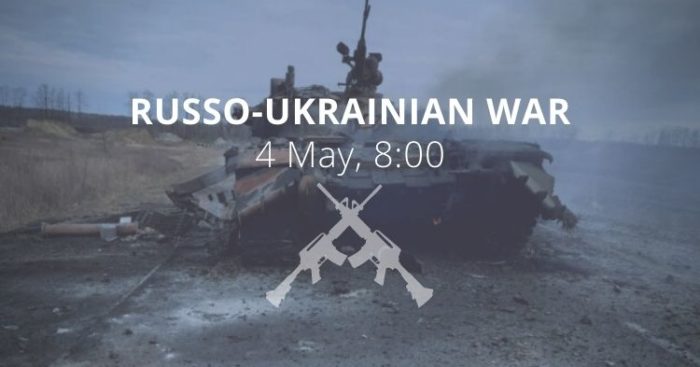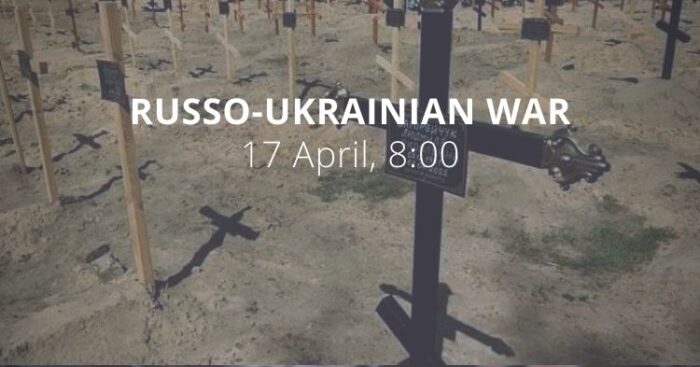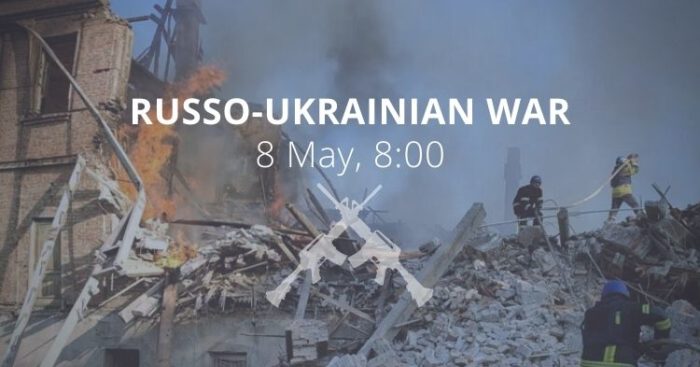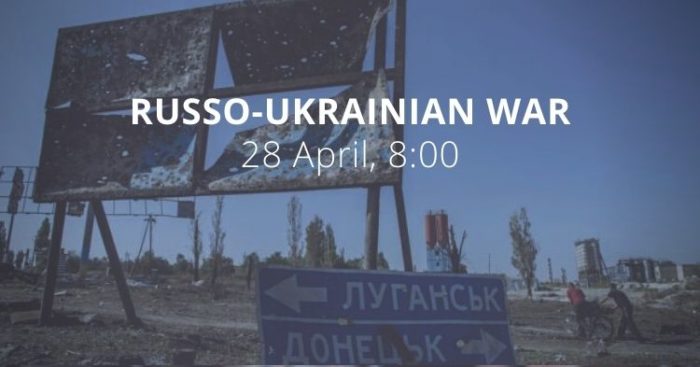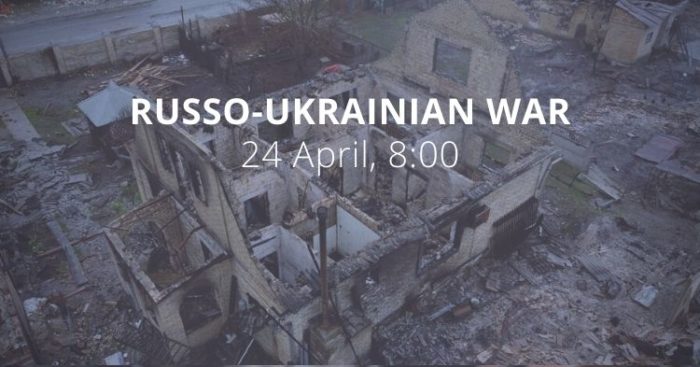Morning report day 70 – May 04
Situation
According to information from the General Staff:
In order to destroy Ukraine’s transport infrastructure, Russian forces fired missiles at facilities in Dnipropetrovsk, Kirovograd, Lviv, Vinnytsia, Kyiv, Zakarpattia, Odesa, and Donetsk oblasts.
In the Volyn and Polissya directions, Russian forces did not take active action, and no signs of the formation of offensive groups were found.
- Certain units of the Armed Forces of the Republic of Belarus continue to carry out tasks to cover the section of the Ukrainian-Belarusian border in the Brest and Gomel oblasts.
- In order to check the readiness to perform the assigned tasks, one missile division of the 465th Missile Brigade of the Armed Forces of the Republic of Belarus is moving from the point of permanent deployment to the destination area.
In the Siversky direction, no signs of the formation of an offensive group by Russian forces were found. As part of strengthening the protection of the Russian-Ukrainian border, units of the Armed Forces of the Russian Federation from the Central Military District have been deployed in the areas of the “Novi Yurkovichi”, “Pohar” and “Lomakovka” checkpoints in the Bryansk Oblast.
- In the area of the settlement of Khmelivka, Sumy Oblast, the activities of a sabotage and reconnaissance group were exposed.
In the Slobozhansky direction, Russian forces fired artillery and mortar shells at the city of Kharkiv and the village of Protopopivka. They conducted air reconnaissance in the area of Kutuzivka and Oleksandrivka settlements of Barvinkovsky district of Kharkiv oblast. Russian forces tried to conduct offensive operations in the direction of the settlement of Dovgenke but were unsuccessful.
- Russian forces operate as a group of the 6th Combined Arms Army of the Western Military District, the 41st Combined Arms Army of the Central Military District, and the coastal troops of the Baltic and Northern Fleets.
- In the Izium direction, the forces, by forces of separate units of the 1st Tank Army, the 20th Combined Arms Army of the Western Military District; The 29th, 35th, and 36th Combined Arms Armies, and the 68th Army Corps of the Eastern Military District and Airborne Troops are conducting offensive operations in the direction of Izium-Barvinkove and they suffer losses.
- To support their actions, Russian occupiers moved a battery of 240-mm Tulip heavy self-propelled mortars and a unit armed with Uragan multiple rocket launchers from the Belgorod Oblast to the Izium area.
- In the temporarily occupied territories of Kharkiv oblast, Russian forces continue to carry out filtration measures. To do this, it additionally involves units of the Rosguard.
In the Donetsk and Tavriya directions, in order to restrain action, the occupiers are shelling units of Ukrainian troops.
- Separate units of the 1st and 2nd Army Corps, the 8th and 58th Combined Arms Armies of the Southern Military District; 5th Combined Arms Army and Pacific Fleet of the Eastern Military District; the 2nd and 41st Combined Arms Armies and the 90th Tank Division of the Central Military District and Airborne Forces are conducting offensive operations on a certain section of the line of contact. The occupiers are carrying out airstrikes and artillery shelling of our troops’ positions.
- In the Lyman direction, Russian forces are advancing in the direction of the village of Shandrygolove, and fighting continues. Russian forces strengthened the group of troops and intensified air reconnaissance.
- Russian occupiers carried out assaults in the area of Popasna, and fighting continues.
- In Mariupol, the Russian occupiers continue to launch airstrikes and fire at our positions in the Azovstal area.
- In the Zaporizhzhia direction, the forces carried out assault operations in the direction of the settlement of Orikhiv, without success.
- In Horlivka, more than 100 bodies of mobilized servicemen of the 1st Army Corps who died in the Zaporizhzhia oblast were taken to the central morgue.
- In order to improve the system of logistics, Russian forces continue to deploy in certain areas storage with ammunition, fuel and oil, as well as organized a point for repair and restoration of damaged equipment.
- At the same time, on some borders, Russian forces carry out the equipment of the second line of defense.
In the direction of the Pivdenny Buh directions, in order to destroy the fortification equipment of our positions, Russian forces used artillery, rocket-propelled grenade launchers, and armament of tanks along the entire line of contact. It intensified hostilities in the area of the settlement of Tomyna Balka.
- Russian forces are fighting with the 8th and 49th Combined Arms Armies, the 22nd Army Corps, the Black Sea Fleet Coast Guard and the Airborne Forces to improve the tactical situation and continue to fire on units of our troops.
- The situation in the Bessarabian direction remains tense and under the control.
- The situation in the Transnistrian region of the Republic of Moldova remains difficult. Units of the operational group of Russian troops continue to be in full combat readiness. Armed formations of the Transnistrian region of the Republic of Moldova are serving in an enhanced mode. Preparations are underway for the evacuation of the families of officers of the task force of the Russian troops.
Ships of the Black Sea Fleet in the Black and Azov Seas continue to launch missile strikes on civilian infrastructure in Ukraine, to isolate the area of hostilities, surveillance, and fire support in the coastal direction.
During the previous day, the air defense units of the Air Force and the Land Forces of the Armed Forces of Ukraine hit seven UAVs and 8 cruise missiles, the data are being clarified.
Twelve attacks have been repulsed in Donetsk and Luhansk oblasts over the past 24 hours, six tanks, five artillery systems (three of them – multiple rocket launchers), and fifteen units of armored combat vehicles and nine units of forces vehicles have been destroyed. The forces have lost in other areas.
Units of the Defense Forces of Ukraine continue to inflict losses on Russian forces. Thus, according to available information, as a result of effective and coordinated actions of defenders of Ukraine, units of the 38th Separate Motorized Rifle Brigade of the Armed Forces of the Russian Federation lost about 60 percent of the dead and wounded.”
The Russians started an attack on “Azovstal” in Mariupol, the Ukrainska Pravda reports on Tuesday. Russian forces have started to attack the “Azovstal” plant, which is being defended by the Ukrainian Defense Forces in besieged Mariupol, the Deputy Commander of the Azov Regiment Sviatoslav Palamar (“Kalyna”) said. “We were bombed all night, two civilian women were killed, and now “Azovstal” is being attacked.” According to a media report Tuesday evening the assault failed and the Russian suffered losses.
Russia fired more than 20 missiles at Ukraine in the evening, most of them from the Caspian Sea, the Ukrainska Pravda reports. On the evening of May 3, Russian troops fired more than 20 missiles at various regions of Ukraine, most of them from the Caspian Sea.
“In the evening of May 3 – an air alert throughout Ukraine. Strategic bombers of Russia Tu-95 or Tu-160 launched a missile strike from the Caspian region. Approximately 18 missiles were fired from aircraft, which hit the infrastructure of Dnipropetrovsk, Kirovograd, Lviv, Vinnytsia, Kyiv and Zakarpattia oblasts. Missile strikes were also inflicted on Odesa and Donetsk oblasts from other means, Yuri Ignat, spokesman for the Air Force Command said.
According to preliminary data, at least 8 cruise missiles and 7 drones were shot down by the air defense of the Air Force and the Land Forces on May 3. Ukrainian combat aircraft conducted about ten missile and bomb strikes at forces troops, ammunition depots, and manpower.
At 3 am Russian troops fired on the school of the Esman community, Sumy Oblast
2 strikes from a helicopter and 2 from ground hit the school, infrastructure. 6 am: Grad artillery shelling along border(Yunakivka) &helicopter strikes near Mohrytsia,–OblHead https://t.co/RCg8ZPfmCb pic.twitter.com/8FvIgEGVjP
— Euromaidan Press (@EuromaidanPress) May 4, 2022
Russian army fires at six railway stations, the damage is severe, the Ukrainska Pravda reports. On Tuesday evening, Russian troops struck six stations in central and western Ukraine. This was reported by Oleksandr Kamyshin, the head of Ukrzaliznytsia UZ, the national railway company. “The damage to the infrastructure is severe. Details will be clarified after the air raid alert is over”, said Kamyshin. These include railway stations in or near Lviv, Dnipropetrovsk, Kirovograd, and Volovets.
Bayraktar drones destroy Russian command post on Zmiinyi Zmiinyi (Snake) Island, the Ukrinform reports. The Armed Forces of Ukraine used Bayraktar drones to attack Zmiinyi (Snake) Island, earlier captured by Russian invaders, and destroyed a Russian ammunition depot and a command post, the Operational Command South said on Facebook.
Today at dawn near Zmiyinyy Island Ukrainian army destroyed two Russian Raptor boats with the help of Bayraktars, Commander-in-Chief of Ukraine's Armed Forces Valeriy Zaluzhnyy reported https://t.co/FAFYR0Lqbw pic.twitter.com/VFp7LGhcBf
— Euromaidan Press (@EuromaidanPress) May 2, 2022
Forces operations centre and three ammunition depots were destroyed in southern Ukraine, the Ukrinform reports. “Our rocker and artillery units have completed more than 40 fire missions. Along the administrative border of Mykolaiv Oblast and Kherson Oblast, we destroyed a command operations center, three ammunition depots, one fuel and oils depot, and several groups of forces troops and military equipment. The total losses are yet to be reported,” the report states. The relevant statement was made by the Operational Command South on Facebook.
According to British Defense Intelligence, (last 24 hours):
- Russia has deployed 22 battalion tactical groups near Izium in its attempt to advance along the northern axis of the Donbas.
- Despite struggling to break through Ukrainian defenses and build momentum, Russia highly likely intends to proceed beyond Izium to capture the cities of Kramatorsk and Sievierodonetsk.
- Capturing these locations would consolidate Russian military control of the north-eastern Donbas and provide a staging point for their efforts to cut-off Ukrainian forces in the region.
As of Wednesday 04 May, the approximate losses of weapons and military equipment of the Russian Armed Forces from the beginning of the war to the present day: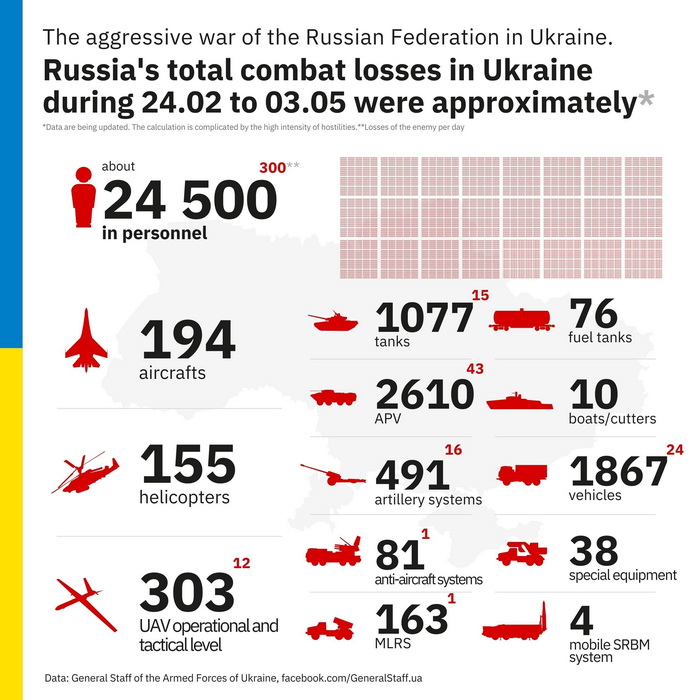
- Personnel – more than 24500 people (+300),
- Tanks – 1077 units (+15),
- Armored combat vehicles – 2610 units (+43),
- Artillery systems – 491 (+16),
- Multiple rocket launchers – 163 (+1)
- Air defense means – 81 (+1),
- Aircraft – 194 (+0),
- Helicopters – 155 (+0),
- Automotive technology and fuel tanks – 1867 (+24),
- Vessels/boats – 10 units (+0),
- UAV operational and tactical level – 303 (+12)
- Special equipment – 38 (+6)
- Mobile SRBM system – 4 (+0)
- Cruise missiles – 87 (+3)
Russian forces suffered the greatest losses (in the past day) in the Izium Novopavlivsʹk directions.
Humanitarian
Haidai says Russians want to engineer famine in Luhansk Oblast as grain elevator in Rubizhne is destroyed, the Ukrainska Pravda reports.
“The objective is a Holodomor. The occupiers bombed the elevator in Rubizhne from the air. Satellite images from Planet Lab show that powerful Russian bombs were dropped on the territory of Golden AGRO LLC in Rubizhne. A grain elevator complex opened in 2020 has been totally destroyed,” Head of Luhansk Oblast Military Administration, Serhii Haidai, wrote on Telegram.
“Haidai said that Golden AGRO had a laboratory with state-of-the-art equipment, including an express analyzer that provided accurate and rapid analyses of all crops, as well as a grain dryer with a capacity of 1,500 tonnes per day, a separator, weighbridges, and an automatic sampler. The elevator complex could store 30,000 tonnes of grain.
Haidai also recalled that in the occupied cities there have been cases of Ukrainian grain being exported to Russia. And earlier, the invaders destroyed all the food warehouses in Sievierodonetsk.”
According to the Deputy Prime Minister and Minister of Reintegration of Temporarily Occupied Territories of Ukraine as of May 3, “We managed to evacuate 156 civilians from Azovstal. Although considering our calculations, there are still several hundreds of civilians hiding in the basements of these plants.” As of May 4, evacuation from Mariupol is still ongoing.
- Russians neglected the ceasefire rule and as of May 3, after heavy shelling of Azovstal, 2 women were found dead in the damaged basements of the plants. More than 600 injured Ukrainian defenders are still on the territory of sieged Azovstal, the Ukrinform reports.
- According to the Azov regiment, “after the heavy shelling, around 100 civilians were saved by Azov troops from the rubbles of damaged areas of the plants. We are calling to prolong the ceasefire and urgently evacuate people to the city of Zaporizhzhia. None of the injured defenders of Mariupol was evacuated so far, which conflicts with the international humanitarian law.”
An 87-year-old Ukrainian woman who survived the Holocaust and Nazi siege of Leningrad says the destruction of Mariupol by Russian forces is worse.
This is the last story produced by journalist Vira Hyrych before she was killed by Russian missile strike.https://t.co/QH0uNBKvFR— Euromaidan Press (@EuromaidanPress) May 4, 2022
According to UNHCR 5,597,483 refugees have been registered as of May 2. The UN says that so far Poland has taken in 3,075,240 refugees, Romania 836,173, Russian Federation 681,156, Hungary 534,821, Republic of Moldova 448,170, Slovakia 382,024 and Belarus 25,002. Among those who fled Ukraine are also Ukrainian nationals with dual citizenship. An additional 105,000 people moved to the Russian Federation from the Donetsk and Luhansk oblasts between 18 and 23 February.
The number of Ukrainians entering Ukraine since February 28 is 1,384,500 as of May 2. This figure reflects cross-border movements, which can be pendular, and does not necessarily indicate sustainable returns.
https://twitter.com/EuromaidanPress/status/1521773211788193793?s=20&t=QAUVK-F6NNeCmY1jjP6DNg
OHCHR recorded 6,546 civilian casualties in Ukraine as of May 2. 3,193 were killed (including 227 children) and 3,353 injured (including 321 children).
Legal
Despite sanctions, Western companies supplying products to Russian arms manufacturer Almaz-Antey, the Ukrainska Pravda reports.
“Despite sanctions imposed on the Russian arms manufacturer Almaz-Antey in 2014, Western companies have continued to supply them with products. This was said by businessman and former Minister of the Cabinet of Ministers of Ukraine Dmitro Dubilet, who together with the team has been involved in monitoring business sanctions against Russia since the beginning of the full-scale war.
He said that before the start of the full-scale war, 116 companies were spotted in the tenders of the Almaz-Antey concern. Almaz-Antey is a key Russian military company that manufactures “Buk” anti-aircraft missile systems, S300, S400, S500 missile systems, and other weapons. It has been under sanctions since 2014, but many Western companies have continued to supply it with their products until recently, Dubilet wrote.
The list includes companies from Switzerland, the United States, China, the Czech Republic, Germany, Britain, Japan, Israel, and Taiwan. It includes such well-known brands as Peugeot, Canon, Toyota, Samsung, Asus, Hewlett-Packard and Nvidia. He emphasized that it is important for the West to understand that some sanctions are not working.“
https://twitter.com/EuromaidanPress/status/1521729333819154433?s=20&t=QAUVK-F6NNeCmY1jjP6DNg
Ukrainian prosecutor says Russia uses rape as a war tactic, and calls Putin a war criminal, the Reuters reports. Ukraine’s prosecutor general accused Russia on Tuesday of using rape as a tactic of war and described Russian President Vladimir Putin as “the main war criminal of the 21st century”. Russia has previously denied targeting civilians and has rejected allegations that its forces have committed war crimes in Ukraine.
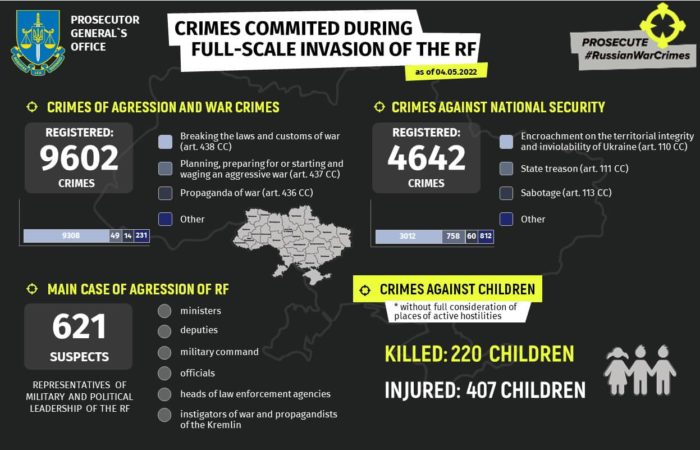 220 children were killed, and 407 children injured, the Office of the Prosecutor General of Ukraine reports as of May 4. 1,584 educational establishments are damaged as a result of shelling and bombings, 118 of them are destroyed fully. 9,602 crimes of aggression and war crimes and 4,642 crimes against national security were registered.
220 children were killed, and 407 children injured, the Office of the Prosecutor General of Ukraine reports as of May 4. 1,584 educational establishments are damaged as a result of shelling and bombings, 118 of them are destroyed fully. 9,602 crimes of aggression and war crimes and 4,642 crimes against national security were registered.
Support
Ukraine’s National Bank has already disbursed UAH 15.6 billion for army needs, the Ukrainska Pravda reports. “In total, the equivalent of more than UAH 15.7 billion has been deposited in this special account since its opening. In particular, the equivalent of more than UAH 4.9 billion has been deposited from abroad in foreign currency. The funds came from citizens and businesses in Ukraine, as well as from the international community (including the United States, Britain, Germany, Sweden, Finland, Poland, Switzerland, Norway, Australia, France, Canada, Bulgaria, Hong Kong, and many other countries),” – the National Bank reports.
Polish Ambassador to Ukraine Bartosz Cichocki awarded the Deputy Minister of Defense of Ukraine Oleksandr Polischuk the Commander's Cross of Merit to the Republic of Poland.
Zelenskyy congratulated Andrzej Duda with Poland's Constitution day celebrated on 3rd May. https://t.co/Dx6SNy1MGZ pic.twitter.com/yaq5ni5uUM
— Euromaidan Press (@EuromaidanPress) May 4, 2022
The British Government will announce a new £300m package of defensive military aid for Ukraine and send specialised civilian protection vehicles, the UK government announced.
“Ministers updated Parliament last week on plans to send sophisticated land Brimstone missiles and STORMER air defense vehicles to Ukraine. The Prime Minister will today set out a new package of military aid today worth £300 million, to support Ukraine’s ongoing defense against Russia’s illegal invasion. The package includes electronic warfare equipment, a counter-battery radar system, GPS jamming equipment and thousands of night vision devices. The UK will also send in the coming weeks heavy lift systems to provide logistical support to isolated forces, and more than a dozen new specialised Toyota Landcruisers to help protect civilian officials in Eastern Ukraine and evacuate civilians from frontline areas, following a request from the Ukrainian government.”
The German government will deliver self-propelled howitzers 2000 to Ukraine, the Welt reports. According to WELT information, the federal government has decided to deliver seven Panzerhaubitz 2000 from Bundeswehr stocks to Ukraine. The Netherlands had previously promised Kyiv the delivery of five howitzers. The training is to take place in Germany. According to WELT information, the political decision of the Chancellery and the Ministry of Defense was made against the advice of leading military personnel in the Bundeswehr. They had pointed out that only around 40 of the 119 Panzerhaubitzen 2000 in the Bundeswehr’s inventory were operational and indispensable for their own needs. The Panzerhaubitz 2000 are heavy artillery pieces that can engage targets up to 40 kilometers.
Sweden and Poland to host international donor conference for Ukraine, the Sverige Radio reports. “Sweden and Poland will host an international donor conference for Ukraine in Warszaw on Thursday. The aim is to get countries and organizations to commit money to help with the immediate humanitarian crisis in Ukraine, but also the country’s more long-term needs.”
The EU is set to unveil sanctions on Russian oil as fighting rages in Ukraine, the Reuters reports.
“Pummelled by Western sanctions, Russia now faces new measures from the EU that would target its banks and oil industry – a major step for European countries that rely heavily on Russian energy. European Commission President Ursula von der Leyen is expected to spell out the proposed new sanctions on Wednesday, including a ban on imports of Russian oil by the end of this year.”
New developments
- President Biden says the cost of the fight for Ukraine not going to be cheap, but caving in to aggression would be more costly, the Ukrinform reports. US President Joe Biden has said that dictators like Putin must be stopped, and their aggression must be resisted, no matter how high the price. “If you don’t stand up to dictators, history has shown us, they keep coming, Biden said. He noted that since Russia invaded Ukraine over two months ago, the United States has sent more than $3 billion in security assistance to Ukraine. This money is a direct investment in defending freedom and democracy itself, he said. Biden stressed that the cost of the fight against the Kremlin dictator is not going to be cheap, but caving in to aggression would be even more costly.”
- Don’t assume ‘imperialistic’ Putin won’t attack other countries, Scholz says, the Reuters reports. German Chancellor Olaf Scholz said on Tuesday no one could assume that Russia would not attack other countries given its violation of international law in Ukraine. “Russia’s invasion of Ukraine broke the post-WW2 order and was forcing Europe to bolster its defense strategy, Scholz said in a statement to the media. “Putin wants to expand his territory and push borders with violence,” he said. “He is desperately trying to re-establish Russia’s old significance in a world that has changed.”
- Pentagon: If Putin uses chemical weapons, international response “will be significant“, the Ukrinform reports. “The United States and the international community stand ready to provide a significant response to any attempt by Russian forces to use chemical or biological weapons in Ukraine. This was stated by US Secretary of Defense Lloyd Austin at a Senate hearing on Tuesday.”
- Putin puts West on notice: Moscow can terminate exports and deals, the Reuters reports. President Putin signed a broad decree on Tuesday which forbade the export of products and raw materials to people and entities on a sanctions list that he instructed the government to draw up within 10 days. “The decree, which came into force with its publication, gives Moscow the power to sow chaos across markets as it could at any moment halt exports or tear up contracts with an entity or individual it has sanctioned. The decree sets out retaliatory special economic measures in connection with the unfriendly actions of some foreign states and international organizations“.
- Russian Ministry of Foreign Affairs accuses Israel of supporting Ukrainian “neo-Nazis”, the Ukrainska Pravda reports. “We have drawn attention to the anti-historical statements of Israeli Minister of Foreign Affairs Yair Lapid, which largely explain the current Israeli government’s course in support of the neo-Nazi regime in Kyiv,” the Russian Ministry of Foreign Affairs wrote on Twitter.
- Ukraine’s Parliament asks the United States to recognize Russia as a state sponsor of terrorism, the Ukrinform reports. “The Verkhovna Rada supported the Appeal No. 7341 to the House of Representatives and the Senate of the US Congress to recognize Russia as a state sponsor of terrorism,” MP Yaroslav Zheleznyak posted on Telegram. The recognition of the Russian Federation as a state sponsor of terrorism would strengthen international sanctions against it and consolidate the support of Ukraine.
- A decision on Ukraine’s neutral status should be made in a referendum, the Ukrinform reports. “Ukraine may adopt a neutral status only if it has serious security guarantees from specific countries. Russia must also accept these guarantees. Afterward, they will be put to a referendum, and the final decision will be made by the Ukrainian people”.
- The Verkhovna Rada has banned the activities of pro-Russian parties, the Ukrainska Pravda reports. In March the National Security and Defense Council suspended parties in Ukraine with ties to the Russian Federation, including the “Opposition Platform – For Life”, “Sharia Party”, “Ours”, “Opposition Bloc”, “Left Opposition”, “Union of Left Forces”, “and more. On April 14, the faction of the pro-Russian “Opposition Platform – For Life” suspended its work in parliament. Today the Verkhovna Rada banned the activities of pro-Russian parties in Ukraine.
Assessment
On the War
The Institute for the Study of War has made the following assessment as of Tuesday 3 May:
A significant Ukrainian counteroffensive pushed Russian forces roughly 40 km east of Kharkiv City. A senior American defense official reported the Ukrainian operation, which is consistent with social media reports from both Ukrainian and Russian sources that Ukrainian troops took control of Staryi Saltiv on May 2. This Ukrainian counteroffensive is unlikely to affect Russian ground lines of communication (GLOCs) to Izium, as the Russians have not been relying on GLOCs from Kharkiv to support their operations in Izium but have been using routes further to the east and well beyond the most recent Ukrainian counteroffensive’s limit of advance. The Ukrainian counteroffensive may, however, unhinge the Russian positions northeast of Kharkiv and could set conditions for a broader operation to drive the Russians from most of their positions around the city. This possibility may pose a dilemma for the Russians—whether to reinforce their positions near Kharkiv to prevent such a broader Ukrainian operation or to risk losing most or all of their positions in artillery range of the city. https://twitter.com/EuromaidanPress/status/1521711926212018176?s=20&t=QAUVK-F6NNeCmY1jjP6DNg Russia’s long-term intentions regarding the status of Mariupol and other occupied areas seem confused. Some anecdotes from Mariupol indicate that Russia may plan to incorporate Mariupol and the surrounding environs into the Donetsk People’s Republic (DNR), and possibly annex the DNR to the Russian Federation. Other anecdotes suggest that Russia could directly absorb Mariupol into Rostov Oblast. These inconsistencies could simply be artifacts of reporting or confusion on the ground, but they could also indicate actual confusion about Russia’s long-term plans for governing the Ukrainian regions that Moscow’s forces currently occupy. These anecdotes clearly support the assessment that Putin has no intention of ceding occupied territories back to an independent Ukraine and is, at most, considering exactly how he intends to govern regions that Russia has illegally seized. Key Takeaways Russian army says that war is planned to continue until September, the Ukrainska Pravda reports. Information is being spread among the military of the occupier’s army that the term of the so-called “special military operation” is set to last until September 2022 the Defense Intelligence of Ukraine (DIU) claims. According to DIU, the Russian Federation is preparing to rule the occupied Ukrainian land territories. The Russian Federation is considering the possibility of including the occupied territories of southern Ukraine in temporarily occupied Crimea and their further integration into the Russian economic space. The development of a plan with a deadline of at least 2030 was announced on May 1 by the adviser to the so-called “head” of Crimea on information policy Oleg Kryuchkov. Consequences and what to do? “Russia’s War Has Been Brutal, but Putin Has Shown Some Restraint. Why?” Anton Troianovski and Julian E. Barnes ask in an article published in The New York Times. … Russia’s war against Ukraine has leveled cities, killed tens of thousands of people, and forced millions of others from their homes. But quietly, some military analysts and Western officials are asking why the onslaught has not been even worse. Russia could be going after Ukrainian railways, roads, and bridges more aggressively to try to stanch the flow of Western weapons to the front line. It could have bombed more of the infrastructure around the capital, Kyiv, to make it harder for Western leaders to visit President Volodymyr Zelenskyy in shows of unity and resolve. And it could be doing far more to inflict pain on the West, whether by cyberattack, sabotage or more cutoffs of energy exports to Europe. Part of the reason appears to be sheer incompetence: The opening weeks of the war demonstrated vividly that Russia’s military was far less capable than believed before the invasion. But American and European officials also say that Russia’s tactics in recent weeks have appeared to be remarkably cautious, marked by a slow-moving offensive in eastern Ukraine, a restrained approach to taking out Ukrainian infrastructure, and avoidance of actions that could escalate the conflict with NATO. The apparent restraint on the ground stands in contrast to the bombast on Russian state television, where Moscow is described as being locked in an existential fight against the West and where the use of nuclear weapons is openly discussed. The issue is whether, as the war grinds on, Mr. Putin will change tack and intensify the war. That is a particularly urgent question ahead of the Victory Day holiday in Russia next Monday when Mr. Putin traditionally presides over a grandiose parade marking the Soviet triumph over Nazi Germany and gives a militaristic speech. Ben Wallace, the British defense secretary, predicted last week that Mr. Putin would use the speech for an official declaration of war and a mass mobilization of the Russian people. American and European officials say that they have not seen any on-the-ground movements that would show any much larger push with additional troops beginning on May 9 or soon after. Those officials now expect a slower, grinding campaign inside Ukraine. But they do not disagree that Mr. Putin could use the speech to declare a wider war and a deeper national effort to fight it. For the moment, Mr. Putin appears to be in a military holding pattern, one that is allowing Ukraine to regroup and stock up on Western weaponry. On Monday, a senior Pentagon official called Russia’s latest offensive in eastern Ukraine “very cautious, very tepid.” In Russia, there is grumbling that the military is fighting with one hand tied behind its back, with the strategy and aims not understood by the public. “This is a strange, special kind of war,” Dmitri Trenin, until recently the director of the Carnegie Moscow Center think tank, said in a phone interview from outside Moscow. “Russia has set some rather strict limits for itself, and this is not being explained in any way — which raises a lot of questions, first of all, among Russian citizens.” …. He said that he was struggling to explain why the Kremlin was fighting at “less than half strength.” Why isn’t Russia bombing more bridges and railway networks, he asked, when they are allowing Ukraine’s military to receive more of the West’s increasingly lethal weapons deliveries with every passing day? Why are Western leaders — like House Speaker Nancy Pelosi on Sunday — still able to visit Kyiv safely? … For weeks, officials in Washington have discussed why the Russian military has not been more aggressive in trying to destroy the supply lines that send Western arms shipments into Ukraine. Part of the answer, officials say, is that Ukrainian air defense continues to threaten Russian aircraft, and the deeper Russian planes go into Ukraine the greater the chance they are going to be shot down. Russia has also struggled with its precision munitions — missiles or rockets with guidance systems. Many of those weapons have failed to work properly, and Russian supplies of the weapons are limited. Strikes on rail lines or moving convoys must be very precise to be effective. Other officials have argued that Moscow is eager to avoid destroying Ukraine’s infrastructure too severely, in the possibly misguided hope that it can still take control of the country. Russia would be stuck with a huge rebuilding job if it took over cities devastated by its own bombing. A senior American defense official said that Mr. Putin may have avoided destroying Ukraine’s rail network because he did not want to hurt his own ability to move equipment and troops around the country. The Russians have been more focused on destroying weapon storage areas than the rail network. …] Then there is the question of why Russia hasn’t hit back harder against the West. The Kremlin narrative is of an existential war with NATO being fought on Ukrainian soil, but Russia is the one taking military losses while the West keeps a safe distance and supplies weapons that kill Russian soldiers. “A lot of people in this town are asking why they haven’t retaliated yet,” said Samuel Charap, a former US State Department official in Washington and a Russia analyst with the RAND Corporation. … Russia has the tools to do widespread damage to the West. The gas shortages caused by the cyberattack on the Colonial Pipeline last year showed the disruption that Russian hacking can inflict on American infrastructure. Berlin has warned that a cutoff of Russian gas could throw the German economy into a recession. … Mr. Putin has also warned of retaliation, but he values ambiguity, too. Last year, he said that those crossing a “red line” would face an “asymmetric, fast and tough” response — an indication that the response would come at a time and place of Moscow’s choosing. … American and allied officials have debated why Mr. Putin hasn’t tried widespread or more damaging cyberstrikes. Some say that Mr. Putin has been effectively deterred. The Russian military, struggling to make gains in Ukraine, cannot handle a wider war with NATO and does not want to give the alliance any excuse to enter the war more directly. Others argue that a cyberstrike on a NATO country is one of the few cards Mr. Putin can play and that he may be waiting for a later stage in his campaign to do that. While Mr. Putin has been unafraid of escalating the rhetoric, his actions have suggested he does not want to do anything that could prompt a wider war. “The general sense is that he wants to snatch some sort of victory out of this debacle of his,” said the American defense official, suggesting that Mr. Putin was not interested in “borrowing more trouble.” Mr. Trenin says he still sees Mr. Putin as fundamentally rational, rather than someone willing to engage in a nuclear war, with a “maniacal determination to destroy mankind.” “That would not be a mistake — that would be a total departure from rationality,” Mr. Trenin said. “Russia’s War Has Been Brutal, but Putin Has Shown Some Restraint” is an interesting observation for several reasons. On a tactical and operational level, it is hard to see any signs of restraint. We have instead seen fundamental flaws in the Russian Armed Forces, including inadequate command and control, technical flaws and problems, lack of logistic support, inability to operate according to the principles of war, and manning problems due to the high number of casualties. The human factor has a huge impact. The soldier’s motivation to fight (or the lack of thereof), as well as their willingness to commit unspeakable atrocities, has defined the war until now. The fierce and professional resistance of the Ukrainian Armed Forces, in combination with civilian resistance and mobilization in support of their country, as well as weapon support from the West have helped “restrain” the Russian Armed Forces. Not Russian “restraint”. On a strategic level, I would also argue that President Putin’s decision to invade Ukraine is anything but restraint. The indiscriminate attacks on residential areas, the systematic war crimes we have witnessed in liberated villages and cities, the forced dislocation of Ukrainians to remote areas of Russia, the destruction of livelihood, and the preparation for what might potentially become another “Holodomor” induced hunger catastrophe, its war against global food security are not a demonstration of restraint. That said, Russia could and can do more. Both Kremlin and Russian media have highlighted that it is at “war” with the West. It is both reflected in its strategic documents where NATO is described as a threat as well as its strategic messaging. On 25 April President Vladimir Putin accused the West of trying to destroy Russia. The international sanctions have been described as an act of aggression. Officials have claimed the West is waging a total (hybrid war), economic, information, and cultural war against Russia. Lavrov views NATO as being “in essence” engaged in a proxy war with Russia. Being “at war with the West”, the Russian Federation has still abstained from engaging NATO in a military confrontation. It has not yet targeted western weapon supplies before it is delivered to Ukraine. While it has threatened to use nuclear weapons, it still remains dormant. Instead, Russia continues its Hybrid War against the West. Hybrid War is the parallel and synchronized use of both military and non-military means to destabilize nations from within. Synchronization is the ability to effectively coordinate the employment of both military and non-military means in time, space, and purpose to create the desired effects. Its use of military force in Ukraine (and elsewhere) has an impact on how we perceive the threat from Russia and our strategic considerations, including the decision to not deploy military forces to Ukraine. The ability to effectively coordinate the employment of both military and non-military instruments means that the latter becomes a force multiplier. The non-military means encompass diplomatic, political, energy, economic, information, legal, and security (e.g., cyber, criminality, and terrorism) instruments. Russia has modified warfare from direct destruction to the direct influence of the West. It has ramped up its efforts within all of these sectors during the last six months trying to influence the minds of both populations and key policy and decision-makers. And it is succeeding. We are still keeping the war at a safe distance. The military options are still off the table. But this is also where my understanding of the Hybrid War coincides with some of the observations presented in The New York Times article. “While Mr. Putin has been unafraid of escalating the rhetoric, his actions have suggested he does not want to do anything that could prompt a wider war.” “The Russian military, struggling to make gains in Ukraine, cannot handle a wider war with NATO and does not want to give the alliance any excuse to enter the war more directly.” In my report “Crimean Platform: Hybrid component in Crimea’s occupation” I concluded that the Hybrid War is designed to avoid a confrontation with the West. The conclusion still stands. So does the conclusion that Russia is still influencing the cognitive space of Western decisions and policymakers.
Assessment by Hans Petter Midttun:




